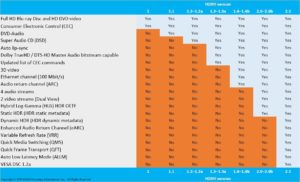HDMI standards are being raised again to keep up with today’s technological advances. This year the latest HDMI standard 2.1 is finally here with features such as dynamic HDR, eARC, and game mode VRR. All three of these features are going to benefit the user providing an even more fluid and detailed experience.
Now you may think, “A new HDMI? Is that going to change the port?” The answer is no. Believe it or not, HDMI has had several upgrades since its introduction in 2004.
The chart above shows the difference in the overall changes in HDMI standards. Over the years new features have been added to HDMI to keep up with the current technological trends. You may have not known that HDMI has changed over the time as you may have never experienced issues with HDMI compatibility. The reason is, an older HDMI cable will still transmit digital video/audio signals between your devices. Yet, when doing this, you will not experience the full features of your equipment. An older HDMI does not support newer technology.
Features of 2.1
HDMI 2.1 standard supports higher video resolutions and refresh rates of 8K60 and 4K120 with resolutions up to 10K. Bandwidth has been upgraded to 48Gbps. This allows ultra high-bandwidth depended features to deliver uncompressed 8K video with HDR. The 2.1 standard also features an exceptionally low EMI, electro-magnetic interface. EMI reduces the possible interference with wireless devices nearby.
Dynamic HDR
HDR stands for High Dynamic Range, This is what gives a dark to bright contrast range. Dynamic HDR gives an extended range for deeper blacks and brighter whites on a frame by frame basis. This is already an availability, however, this now ensures that HDR technology is available without a proprietary format, such as Dolby Vision.
eARC
EARC is the next generation of ARC (Audio Return Channel). ARC removed the need to use an optical cable allowing HDMI to send audio along with video. With eARC you will get a big boost in bandwidth and speed. So this means you will get higher quality audio. You will now be able to run Dolby Atmos over an ARC connection with full resolution, allowing you to ditch the optical cable without sacrificing sound quality.
Game Mode VRR
Despite its name, game mode VRR will bring smooth and seamless motions and transitions for more than just gaming. GMVRR is greatly going to benefit video streaming. Streaming has made its way into our homes. In fact over 62% of adults subscribe to at least one streaming service. There are a few components to Game Mode VRR.
Variable Refresh Rate (VRR)
VRR, or variable refresh rate, will provide an advanced detailed gameplay. VRR will eliminate or reduce lag, judder and frame tearing resulting in a more fluid experience. When a gaming source delivers video frames, it is in most cases, slower than the typical static refresh rate as graphics processors render each frame in different absolute periods. VRR in HDMI 2.1 will wait until the next frame is ready before transporting it. This eliminates or reduces judder and tearing and a smoother gaming experience.
Auto Low Latency Mode (ALLM)
Automatically sets the ideal latency setting. This helps produce a smooth, lag-free and uninterrupted viewing. Currently game mode exists in menus and settings. This is not an ideal placement as you will have to remember and then go through the menus to turn it on and off for gaming sessions. With ALLM, when the source no longer requires game mode the source automatically disables the mode so you can go back to watching TV without interruption. This mode will also benefit video conferencing.
Quick Media Switching (QMS)
Quick Media Switching is a feature that eliminates the delay that can cause the blackout period before content is displayed when switching video modes. Sometimes when streaming there can be a difference in frame rates between videos. When switching between a 50Hz or a 60Hz rate the entire system has to change it clocking and re-sync. This causes an A/V blackout and you may miss the first few moments of your video as your system switches modes. QMS will help give you the seamless experience you’ve been waiting for.
Quick Frame Transport (QTF)
Quick Frame Transport, QFT, is another technology that reduces lag and latency within the system. QFT will help with real time interactive virtual reality and will enable 3D graphics processors to render and display images in real time.
Do I Need The New Ultra High Speed HDMI?
You don’t have to go out and buy an HDMI 2.1 right this minute. You just need to consider it when you are purchasing new equipment, such as a television, or perhaps a new gaming console that is due to release later this year. Your older HDMI cables will still work with new equipment, however, you will not get to experience all the capabilities your new equipment may offer. HDMI 2.1 is backwards comparable. So even if you don’t need all the features today, you will still be able to use it in the near future. If you are in the market for a new HDMI cable, you may as well pick up the new Ultra High Speed HDMI Cable with 2.1 specifications.










